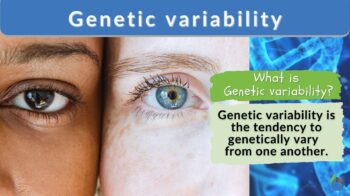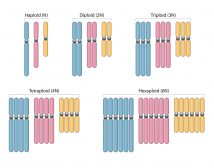
Genetic variability
n., plural: genetic variabilities
[d͡ʒəˈnɛtɪk ˌvɛɹ.i.ə.ˈbɪl.ə.ti]
Definition: the propensity to vary genetically
Table of Contents
Genetic Variability Definition
Genetic variability refers to the tendency of individual genetic characteristics in a population to vary from one another. It may also refer to the potential of a genotype to change or deviate when exposed to environmental or genetic factors.
Genetic Variability vs Genetic Variation
Are genetic variability and genetic variation the same? What is the difference between genetic variability and genetic variation? These two concepts can be used interchangeably as both of them refer to genetic change(s) or genetic difference(s). But let’s take a closer look at how these terms are defined both generally and specifically.
In general definition, variation refers to the change or difference in certain aspects, properties, or attributes of objects being compared. In biology, variation refers to the occurrence of varying yet distinct forms for a particular organism (such as the observable variations in physical sizes and colors). In genetics, genetic variation presents changes or differences in the genetic materials, especially genetic sequences, among individuals. The term “human genetic variation“, for instance, refers to the genetic differences in and among human populations.
Genetic variability, as defined above, refers to the tendency to vary genetically. Thus, genetic variability can be one way to measure genetic variation. In Darwin’s theory of natural selection, natural selection will work if there is a significant variation within species. But how do we determine significance? This is where genetic variability could come in and play. Variability of a gene or a trait, for instance, can determine the extent or how much it has altered, e.g., as a response to a particular environmental or genetic factor.
Genetic Variability vs Genetic Diversity

Genetic diversity is defined as the total amount or the number of genetic variations, such as the diversity of genes (alleles) within a species or a population.
Genetic variability is different from genetic diversity.
- Genetic variability measures how much the trait or the genotype will tend to vary.
- Genetic diversity measures the number of actual variations of species in a population.
While genetic diversity can be measured by determining any observed variations or actual variations (observed phenotypes) via gene expressions, genetic variability can be more difficult to measure. At the molecular level, variation among genes may be measured at the molecular level, such as by determining the rate of mutation. In essence, genetic variability tells how far apart or how different they are.

Causes of Genetic Variability
Why does genetic variability occur? There are various possible sources leading to it. Some of them are as follows:
Homologous recombinations
Genetic exchange via chromosomal crossover occurs during meiosis, particularly when the homologous chromosomes come close and pair up. They exchange genes during synapsis where segments of matching regions are exchanged. The extent of this phenomenon can therefore determine the extent of genetic variability. This meiotic event is important as this contributes to genetic diversity. However, if unequal crossover occurs (when unequal amounts of genetic material are exchanged), this could lead to insertion or deletion mutation.

Mutations
Mutations occur from exposure to mutagens or from the inefficiency of fixing replication errors (Read: How cell fixes DNA damage). There are various types of mutations. Some of them are small-scale, affecting nucleotide sequences, such as substitution, deletion, and insertions of genes leading to damaged DNA. Others are large-scale, affecting significant portions of chromosomes or genomic regions.
Not all mutations though will result in an observable change in phenotypes. For example, silent mutation on a gene occurs when the mutation causes no change in the amino acid sequence. However, there are mutations that lead to the formation of new genetic information, trait, or character. And such changes may be deleterious, harming the organism, or beneficial, conferring an evolutionary advantage, especially when there are environmental changes.
Overall, mutations are essential in the evolutionary sense as they are a source of new genes and/or new traits to come up with new and rare variants. They can also change allele frequencies within a population, thus, favoring the gene pool and species diversity.
Factors of Genetic Variability
As discussed above, we’ve seen how genetic recombinations during meiotic cell division and mutations affecting functional genes can drive genetic variability within small and large populations. But what about factors that are negatively correlated to genetic variability?
Geographical factors are one such factor. They can limit genetic variability, for instance, by creating a geophysical barrier that restrains organisms from interacting, and therefore, limiting their sexual reproduction. Habitat loss and fragmentation are examples of geographical factors that hamper inbreeding. They tend to establish genetic distances between and within species, which over time, could lead to speciation, diminished population size, or extinction.
Migration — where animals move to a new habitat — affects genetic variability. For instance, a population that has moved could increase genetic variability when new settlers interact with the other organisms originally inhabiting the area.
Founder effect — where few individuals leave the larger population to start a new colony — can decrease genetic variability. Having only a small number of individuals in a new colony tends to negatively affect genetic variability. Even in plants, this was observed. A study on plant development and offspring fitness in the natural population of Rhododendron brachycarpum showed how the fitness of the progeny decreased with increasing inbreeding. Apparently, the selective pressure promotes outcrossing, which seems to serve as a selective advantage when progeny from outcrossing (distantly related) tended to survive better than progeny from selfing (uniparental breeding) or crossing between closely-related parents (biparental inbreeding). (Hirao, 2010)
High and Low Variability
Genetic variability may be high or low. What does high genetic variability mean? High variability is when there is a high tendency to vary from one another in a population. Conversely, a low genetic variability is when that tendency is relatively low. When the genetic variability is high, the chances of selecting better genotypes are greater. (George et al., 2020)
The amount of heterozygosity — the condition of having two different alleles for a trait — is related to the level of genetic polymorphism (definition: the existence of polymorphic alleles in a population). High heterozygosity could indicate that the population has high genetic variability. (Stephen et al., 2020) Hence, various genetic markers based on such a principle have been made for use in studying genetic variability and diversity. These markers vary — from the early-stage markers, such as (e.g., AFLP or amplified fragment length polymorphism and RAPD or random amplification polymorphic DNA) to advanced markers, e.g., SNPs or single nucleotide polymorphisms.
Research and Importance
Why is genetic variability important? Genetic variability is the basis of evolutionary processes. If you remember, Darwin cited how natural selection depends on the notable variation within species.
Genetic variability can help provide proof of speciation (species development) and the genetic basis of biodiversity. It also renders a deeper understanding of gene flow, genetic drift, heritable variation, population structure, environmental heterogeneity, allele frequencies, and nucleotide diversity.
Molecular techniques, genetic engineering, somaclonal variation, molecular markers, complete genome sequences, and genetic analysis have been employed by various researchers to gain a deeper understanding of genetic variability.
For instance, in agriculture, the vital importance of genetic variability can be easily felt. It is particularly useful in breeding programs and research on plant growth and disease susceptibility. Singh et al., for instance, previously reported how genetic variability for agronomic traits is key to broadening the gene pool of rice and other important crops.
Genetic Differentiation
Genetic differentiation occurs when there is a barrier restricting gene flow between populations. (Pongratz et al., 2002) Natural selection, random genetic drift, and limited migrations are the common causes of genetic differentiation.
There are many instances of genetic differentiation that seem to characterize groups of people, e.g. ethnicity. Let’s take for example the gene that expresses a protein on the surface of the immune cells, the CRR5 gene. Mutation of this given gene that leads to its increased expression has been found to confer protection against HIV, the virus causing AIDS. The said CRR5 gene variant was found to occur more frequently in Northern European populations at around the time of the bubonic plague caused by Yersinia pestis. Scientists claim that the gene variant provided a better immune response, not just against Yersinia pestis but HIV as well. (Health & Study, 2023)
How Unique Are You?
How much do we vary genetically? How diverse are we? The modern human species is relatively young and so has not accumulated much genetic variation, unlike other species that existed much earlier than us and still thrive to this day. Scientists claim that we are about 0.1% different from each other — in other words, for every 1,000 base pairs, about one base pair will be different between two individuals. Scientists call the single base-pair differences SNPs or single-nucleotide polymorphisms. (Health & Study, 2023)
Watch this vid about genetic variability:
Answer the quiz below to check what you have learned so far about genetic variability.
References
Bowler, P. J. (2005). Variation from Darwin to the Modern Synthesis. Variation, 9–27. https://doi.org/10.1016/b978-012088777-4/50004-1
George, R., Thomas, B., & Unni, A. (2020). Genetic variability studies in Phalaenopsis orchids. ~ 377 ~ Journal of Pharmacognosy and Phytochemistry, 9(5), 377–379. https://www.phytojournal.com/archives/2020/vol9issue6/PartF/9-5-610-392.pdf
Health, & Study, C. (2023). Understanding Human Genetic Variation. Nih.gov; National Institutes of Health (US). https://www.ncbi.nlm.nih.gov/books/NBK20363/#:~:text=Between%20any%20two%20humans%2C%20the,different%20between%20any%20two%20individuals.
Hirao, A. S. (2010). Kinship between parents reduces offspring fitness in a natural population of Rhododendron brachycarpum. Annals of Botany, 105(4), 637–646. https://doi.org/10.1093/aob/mcq018
Pongratz, N., Gerace, L., & Michiels, N. K. (2002). Genetic differentiation within and between populations of a hermaphroditic freshwater planarian. Heredity, 89(1), 64–69. https://doi.org/10.1038/sj.hdy.6800102
Stephen, C., Moneva, O., Vega, R., Sangel, P., Angeles, A., & Mendioro, M. (2020). Genetic Variability in the Growth Hormone Gene (A781G) and Its Association with Milk Yield Performance in Crossbred Anglo-Nubian Dairy Goats. Philippine Journal of Science, 149(3), 503–509. https://philjournalsci.dost.gov.ph/images/pdf/pjs_pdf/vol149no3/genetic_variability_in_the_growth_hormone_gene_.pdf
©BiologyOnline.com. Content provided and moderated by Biology Online Editors.








